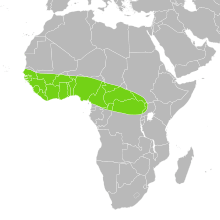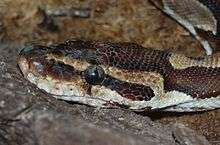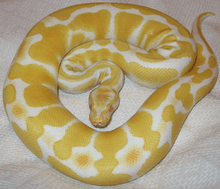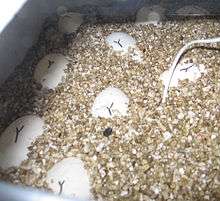Ball python
| Ball python | |
|---|---|
| Scientific classification | |
| Kingdom: | Animalia |
| Phylum: | Chordata |
| Class: | Reptilia |
| Order: | Squamata |
| Suborder: | Serpentes |
| Family: | Pythonidae |
| Genus: | Python |
| Species: | P. regius |
| Binomial name | |
| Python regius (Shaw, 1802) | |
 | |
| Distribution map of ball python | |
| Synonyms | |
The ball python (Python regius), also known as the royal python,[2] is a python species found in sub-Saharan Africa. Like all other pythons, it is a nonvenomous constrictor. This is the smallest of the African pythons and is popular in the pet trade, largely due to its small size and typically docile temperament. No subspecies are currently recognized.[3] The name "ball python" refers to the animal's tendency to curl into a ball when stressed or frightened.[4] The name "royal python" (from the Latin regius) comes from the fact that rulers in Africa would wear the python as jewelry.
Description

Maximum adult length of this species is 182 cm (6.0 ft).[5] Females tend to be slightly bigger than males, maturing around 122–137 cm (4.0–4.5 ft). Males typically grow to around 90–107 cm (3.0–3.5 ft).[6] Their build is stocky,[2] while the head is relatively small. The scales are smooth[5] and both sexes have anal spurs on either side of the vent.[7] Although males tend to have larger spurs, this is not definitive, and sex is best determined by manual eversion of the male hemipenes or inserting a probe into the cloaca to check the presence of an inverted hemipenis (if male).[8] When probing to determine sex, males typically measure eight to 10 subcaudal scales, and females typically measure two to four subcaudal scales.[5]
The color pattern is typically black or dark brown with light brown or gold sides and dorsal blotches. The belly is a white or cream that may include scattered black markings.[5] However, those in the pet industries have, through selective breeding, developed many morphs (genetic mutations) with altered colors and patterns.[9]
Distribution and habitat
They are found in west Africa from Senegal, Mali, Guinea-Bissau, Guinea, Sierra Leone, Liberia, Ivory Coast, Ghana, Benin, and Nigeria through Cameroon, Chad, and the Central African Republic to Sudan and Uganda. No type locality was given in the original description.[1]
The ball python bears a strong physical resemblance to the Burmese python, whose adaptive abilities have caused it to become classified as an invasive species in places such as the Florida Everglades. The ball python, however, has not been known to reproduce in the wild outside of its native range and no reproducing wild populations are known in Florida.[10]
Ball pythons prefer grasslands, savannas, and sparsely wooded areas.[2] but have been shown to adapt to all types of environments. Males tend to display more semi-arboreal behaviours, whilst females tend towards terrestrial behaviours.[11]
Behavior
This terrestrial species is known for its defense strategy that involves coiling into a tight ball when threatened, with its head and neck tucked away in the middle. In this state, it can literally be rolled around. Favored retreats include mammal burrows and other underground hiding places, where they also aestivate. In captivity, they are considered good pets, with their relatively small size and placid nature making them easy to handle.[2]
Diet
In the wild, their diet consists mostly of small mammals, such as African soft-furred rats, shrews, and striped mice and birds. Younger pythons, under 70 cm total length, and males prey almost exclusively on small birds (nestlings and immature young) whilst pythons greater than 70 cm total length, and females prey almost exclusively on small mammals.[12]
Reproduction
Females are oviparous, with 3 to 11 rather large, leathery eggs being laid (four to six are most common).[5] These are incubated by the female under the ground (via a shivering motion), and hatch after 55 to 60 days. Sexual maturity is reached at 11–18 months for males, and 20–36 months for females. Age is only one factor in determining sexual maturity and ability to breed; weight is the second factor. Males breed at 600 g or more, but in captivity are often not bred until they are 800 g (1.7 lb), although in captivity, some males have been known to begin breeding at 300–400 g. Females breed in the wild at weights as low as 800 g though 1200 g or more in weight is most common; in captivity, breeders generally wait until they are no less than 1500 g (3.3 lb). Parental care of the eggs ends once they hatch, and the female leaves the offspring to fend for themselves.[8]
Captivity

%2C_Bronx_Zoo.jpg)
Wild-caught specimens have greater difficulty adapting to a captive environment, which can result in refusal to feed, and they generally carry internal or external parasites. Specimens have survived for over 40 years in captivity, with the oldest recorded ball python being kept in captivity 47 years and 6 months until its death in 1992 at the Philadelphia Zoo.[13]
Hundreds of different color patterns are available in captive snakes. Some of the most common are Spider, Pastel, Albino, Mojave, and Lesser. Breeders are continuously creating new designer morphs, and over 5,300 different morphs currently exist.[14]
Breeding
Ball Pythons are one of the most common reptiles bred in captivity. They usually are able to produce a clutch of six eggs on average, but clutch sizes also range from one to eleven. Ball pythons reach sexual maturity at the age of two to two and a half years and a weight of 1500 grams. These snakes usually lay one clutch per year and the eggs hatch around sixty days later. Usually these eggs are artificially incubated in a captive environment at temperatures between 88-90 degrees Fahrenheit.Some captive breeders use ultra-sounding technology to verify the progress of reproductive development. This can help to increase chances of successful fertilization as the ultra-sound can help predict best times to introduce males and females during breeding season[15].

Beliefs and folklore
This species is particularly revered in the traditional religion of the Igbo people of southeastern Nigeria. It is considered symbolic of the earth, being an animal that travels so close to the ground. Even among many Christian Igbos, these pythons are treated with great care whenever they happen to wander into a village or onto someone's property; they are allowed to roam freely or are very gently picked up and placed out in a forest or field away from any homes. If one is accidentally killed, many communities in Igboland still build a coffin for the snake's remains and give it a short funeral.[16]
See also
- List of pythonid species and subspecies
- Pythonidae by common name
- Pythonidae by taxonomic synonyms
References
- 1 2 McDiarmid RW, Campbell JA, Touré T. 1999. Snake Species of the World: A Taxonomic and Geographic Reference, vol. 1. Herpetologists' League. 511 pp. ISBN 1-893777-00-6 (series). ISBN 1-893777-01-4 (volume).
- 1 2 3 4 Mehrtens JM. 1987. Living Snakes of the World in Color. New York: Sterling Publishers. 480 pp. ISBN 0-8069-6460-X.
- ↑ "Python regius". Integrated Taxonomic Information System. Retrieved 12 September 2007.
- ↑ Ball Python (Python regius) Caresheet Archived 23 May 2007 at the Wayback Machine. at ball-pythons.net. Accessed 12 September 2007.
- 1 2 3 4 5 Barker DG, Barker TM. 2006. Ball Pythons: The History, Natural History, Care and Breeding (Pythons of the World, Volume 2). VPI Library. 320 pp. ISBN 0-9785411-0-3.
- ↑ "Ball Python (Python regius) Basic Husbandry and Feeding: Housing, Diet, Handling, and Care". www.peteducation.com. Retrieved 2017-09-21.
- ↑ Ball python at Pet Education. Accessed 12 September 2007.
- 1 2 McCurley, Kevin. 2005. The Complete Ball Python: A Comprehensive Guide to Care, Breeding and Genetic Mutations. ECO & Serpent's Tale Nat Hist Books. 300 pp. ISBN 978-097-131-9.
- ↑ (P. regius) Base Mutations at Graziani Reptiles. Accessed 12 September 2007.
- ↑ "Ball python". Florida Fish and Wildlife Conservation Commission. Retrieved 8 March 2017.
- ↑ Luca Luiselli & Francesco Maria Angelici (1998) Sexual size dimorphism and natural history traits are correlated with intersexual dietary divergence in royal pythons (python regius) from the rainforests of southeastern Nigeria, Italian Journal of Zoology, 65:2, 183-185, DOI:10.1080/11250009809386744
- ↑ Luca Luiselli & Francesco Maria Angelici (1998) Sexual size dimorphism and natural history traits are correlated with intersexual dietary divergence in royal pythons (python regius) from the rainforests of southeastern Nigeria, Italian Journal of Zoology, 65:2, 183-185, DOI: 10.1080/11250009809386744
- ↑ Kate, Frank; Slavens, Kate (2003). "Python longevity records". Reptiles and Amphibians in Captivity – Longevity (at PondTurtle.com). Retrieved 2016-08-10.
- ↑ "Morph List - World of Ball Pythons". World of Ball Pythons. Retrieved 2017-09-21.
- ↑ Bertocchi, Pelizzone (June 27, 2018). "Monitoring the reproductive activity in captive bred female ball pythons (P. regius) by ultrasound evaluation and noninvasive analysis of faecal reproductive hormone (progesterone and 17β-estradiol) metabolites trends". PLoS ONE. 13 (6). Retrieved 19 September 2018.
- ↑ Hambly, Wilfrid Dyson; Laufer, Berthold (1931). "Serpent worship". Fieldiana Anthropology. 21 (1).
External links
| Wikimedia Commons has media related to Python regius. |
| Wikispecies has information related to Python regius |
- Python regius at the Reptarium.cz Reptile Database. Accessed 12 September 2007.
- Ball Python Articles and Care Sheets at RC Reptiles.com. Accessed 12 September 2007.
- Ball Python Care and Husbandry at Ball Python Care.
- Ball Python Care Sheet at Herphangout. Accessed 12 September 2007.
- Troubleshooting Guide for Ball Pythons at kingsnake.com. Accessed 12 September 2007.
- Ball Pythons as Pets at About.com: Exotic Pets. Accessed 12 September 2007.
- Ball Python, Python regius Care at ReptileExpert.org. Accessed 4 April 2011.
- Royal Python, Python regius Care at The Royal Python. Accessed 17 December 2012.
- Exposure to Salmonella at CDC MMWR. Accessed 21 May 2018.
